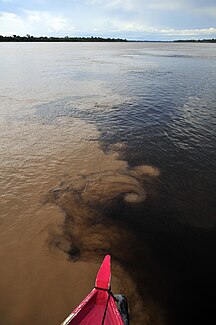Rio Aripuanã
| Rio Aripuanã | ||
|
River system of the Rio Madeira |
||
| Data | ||
| location |
|
|
| River system | Amazon | |
| Drain over | Rio Madeira → Amazon → Atlantic Ocean | |
| Headwaters | southwest of Juína 11 ° 43 ′ 29 ″ S , 59 ° 29 ′ 24 ″ W |
|
| Source height | approx. 500 m | |
| muzzle |
Rio Madeira Coordinates: 5 ° 7 ′ 7 ″ S , 60 ° 22 ′ 55 ″ W 5 ° 7 ′ 7 ″ S , 60 ° 22 ′ 55 ″ W. |
|
| Mouth height | 22 m | |
| Height difference | approx. 478 m | |
| Bottom slope | approx. 0.43 ‰ | |
| length | 1110 km | |
| Catchment area | 146,257 km² | |
| Discharge at the gauge Prainha Velha A Eo : 131,000 km² |
NNQ (1998) MQ Mq HHQ (1997) |
106 m³ / s 3419 m³ / s 26.1 l / (s km²) 12,237 m³ / s |
| Left tributaries | Rio Juma , Rio Branco , Rio Guariba , Rio Roosevelt | |
| Right tributaries | Rio Arauá | |
| Medium-sized cities | Novo Aripuanã | |
| Communities | Terra Roxa, Aripuanã | |
| Residents in the catchment area | 112,000 | |
|
Rio Aripuanã at the confluence with the Rio Madeira |
||
The Rio Aripuanã is a right tributary of the Rio Madeira in Brazil ( South America ).
course
It rises west of Juína in the Serra do Norte mountain range and runs essentially northward over the entire length of about 1200 kilometers. In the city of Aripuanã named after him, the river forms the two large waterfalls Cachoeira das Andorinhas and Cachoeira de Dardanelos . The most important tributary of the Rio Roosevelt flows into Prainha . 300 km further north, at Novo Aripuanã , the Aripuanã flows into the Rio Madeira .
Tributaries
The largest tributaries include (downstream):
- Rio Canamã (right)
- Río Maracanã (right)
- Río Guariba (left)
- Rio Roosevelt (left)
- Rio das Pombas (right)
Species and Conservation
Near Juina and Colniza , large parts of the rainforest near the river have recently been cleared. At the height of Santa Eliseia, the government of the state of Amazonas designated an "Area of Sustainable Use" (RDS) of 5896 square kilometers in 2006. A large part of the area called Juma (named after the tributary that flows in here) has meanwhile been upgraded to a fully protected area. In recent years, numerous new large animal species have been described in this region, including several species of monkeys, a coati, an agouti, a spit deer, a dwarf tapir and, in July 2007, the giant pekari ( Pecari maximus ).
Use of hydropower
To use the river's hydropower, the Juína power plant was built on the upper reaches . At Aripuanã, the Dardanelos , Faxinal I and Faxinal II power plants use the energy from the 100 meter high waterfalls there. These hydropower plants are controversial because of their effects on the ecosystem (residual water volume at least 21 m³ / s) and also led to conflicts with the indigenous population .
See also
Individual evidence
- ↑ a b c Ministério de Minas e Energia et al .: Bacia Hidrográfica do Rio Aripuanã. Estudios de Inventário Hidrelétrico ( Memento of the original from March 5, 2016 in the Internet Archive ) Info: The archive link was inserted automatically and has not yet been checked. Please check the original and archive link according to the instructions and then remove this notice. , Apêndice F - Avaliação Ambiental Integrada (AAI), Tomo 1 - Texto, 2011
- ^ Kümmerly + Frey Rand McNally : International Atlas . Published by Georg Westermann Verlag ISBN 3-07-508962-1
- ^ Foundation for species protection, protection measures in the region of the Rio Aripuanã, Brazil , accessed on September 29, 2012
- ^ Stiftung Artenschutz, Entdeckungen am Amazonas , accessed on Sept. 29, 2012

